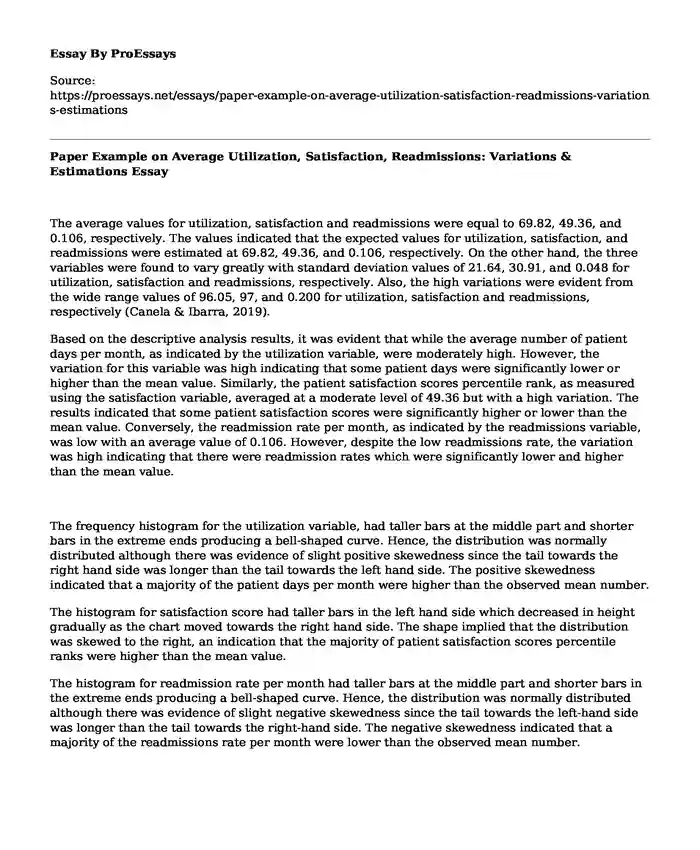The average values for utilization, satisfaction and readmissions were equal to 69.82, 49.36, and 0.106, respectively. The values indicated that the expected values for utilization, satisfaction, and readmissions were estimated at 69.82, 49.36, and 0.106, respectively. On the other hand, the three variables were found to vary greatly with standard deviation values of 21.64, 30.91, and 0.048 for utilization, satisfaction and readmissions, respectively. Also, the high variations were evident from the wide range values of 96.05, 97, and 0.200 for utilization, satisfaction and readmissions, respectively (Canela & Ibarra, 2019).
Based on the descriptive analysis results, it was evident that while the average number of patient days per month, as indicated by the utilization variable, were moderately high. However, the variation for this variable was high indicating that some patient days were significantly lower or higher than the mean value. Similarly, the patient satisfaction scores percentile rank, as measured using the satisfaction variable, averaged at a moderate level of 49.36 but with a high variation. The results indicated that some patient satisfaction scores were significantly higher or lower than the mean value. Conversely, the readmission rate per month, as indicated by the readmissions variable, was low with an average value of 0.106. However, despite the low readmissions rate, the variation was high indicating that there were readmission rates which were significantly lower and higher than the mean value.
The frequency histogram for the utilization variable, had taller bars at the middle part and shorter bars in the extreme ends producing a bell-shaped curve. Hence, the distribution was normally distributed although there was evidence of slight positive skewedness since the tail towards the right hand side was longer than the tail towards the left hand side. The positive skewedness indicated that a majority of the patient days per month were higher than the observed mean number.
The histogram for satisfaction score had taller bars in the left hand side which decreased in height gradually as the chart moved towards the right hand side. The shape implied that the distribution was skewed to the right, an indication that the majority of patient satisfaction scores percentile ranks were higher than the mean value.
The histogram for readmission rate per month had taller bars at the middle part and shorter bars in the extreme ends producing a bell-shaped curve. Hence, the distribution was normally distributed although there was evidence of slight negative skewedness since the tail towards the left-hand side was longer than the tail towards the right-hand side. The negative skewedness indicated that a majority of the readmissions rate per month were lower than the observed mean number.
Summary
The study concluded that the average number of patient days per month, as indicated by the utilization variable, and the patient satisfaction scores were moderately high. The distribution utilization and satisfaction showed that a majority of the observations were higher than the average values. On the contrary, the readmission rate per month was low with the distribution of the values indicating that a majority of observations were lower than the mean. Hence, based on the analysis results, the nursing home administration had achieved on the objectives of higher utilization, higher patient satisfaction, and lower readmissions (Senthilkumar et al., 2018). Based on the average performance over the past 70 months, the study recommends that the stakeholders retain the department manager.
References
Canela, M. Á., Alegre, I., & Ibarra, A. (2019). Summary statistics. In Quantitative Methods for Management (pp. 3-11). Springer, Cham.
Senthilkumar, S. A., Rai, B. K., Meshram, A. A., Gunasekaran, A., & Chandrakumarmangalam, S. (2018). Big data in healthcare management: A review of literature. American Journal of Theoretical and Applied Business, 4(2), 57-69. https://www.researchgate.net/profile/Senthilkumar_Sa/publication/326957164_Big_Data_in_Healthcare_Management_A_Review_of_Literature/links/5d99ba53a6fdccfd0e7b931b/Big-Data-in-Healthcare-Management-A-Review-of-Literature.pdf
Szafir, D. A., Haroz, S., Gleicher, M., & Franconeri, S. (2016). Four types of ensemble coding in data visualizations. Journal of vision, 16(5), 11-11. https://iovs.arvojournals.org/article.aspx?articleid=2504104
Cite this page
Paper Example on Average Utilization, Satisfaction, Readmissions: Variations & Estimations. (2023, Oct 23). Retrieved from https://proessays.net/essays/paper-example-on-average-utilization-satisfaction-readmissions-variations-estimations
If you are the original author of this essay and no longer wish to have it published on the ProEssays website, please click below to request its removal:
- The Olympics of International Financial Institutions' Projects
- Essay Sample on Cigarette Companies: Persuasive Ads, Quadrupled Spending
- Essay Example on Abortion Debate: Escalating Arguments & Controversies
- Opioid Use Disorder: Rise in Cases & Overdose Deaths - Essay Sample
- The Great Pandemic: John Snow's Contributions to Modern Epidemiology - Research Paper
- Elderly Man Tom's Palliative Care: Deciding Morphine & Guardianship - Case Study
- Group Singing: Benefits to Mental & Physical Health - Essay Sample







